Transient Modeling and Performance Analysis of Hydrogen-Fueled Aero Engines
Abstract
:1. Introduction
2. Modeling Challenges for Hydrogen-Fueled Aero Engines
2.1. Hydrogen-Fueled Aero Engine Configurations
2.1.1. ENABLEH2 Configuration
2.1.2. HySIITE Configuration
2.2. Analysis of Modeling Challenges
3. Nonlinear Models of Hydrogen-Fueled Aero Engines
3.1. Modeling of General Aero Engine Component
3.1.1. Environment and Inlet Compression
3.1.2. Compression System
3.1.3. Turbine Expansion
3.1.4. Exhaust System
3.1.5. Rotor Shaft
3.2. Modeling of Hydrogen-Fueled Components
3.2.1. Combustor
3.2.2. Effect of Steam Injection on the Combustor
3.2.3. Modeling of Heat Exchanger
3.3. NOx Emission Assessment
4. Performance Analysis of Advanced Hydrogen-Fueled Aero Engine
- 1.
- Hydrogen fuel needs to heated from 24 K at the outlet of the hydrogen storage tank to 700 K and then be injected into the combustor in both the ENABLEH2 scheme and HySIITE scheme.
- 2.
- In the HySIITE scheme, the flow of steam injected into the combustion chamber is 3% of the gas flow at the outlet of the engine turbine, and steam is injected into the combustor at 100 ℃ and finally reaches the same temperature as the combustor.
- 3.
- Under the same operating point, the fuel flow command corresponding to the PLA is only one proportion coefficient different between the kerosene-fueled model and the hydrogen-fueled model.
4.1. Analysis of Key Performance Parameters under the Same Maximum Thrust
4.2. Analysis of Performance Parameters under Key Operating Points
4.3. Hardware in the Loop (HIL) Simulation Results
5. Conclusions
- By referencing two hydrogen-fueled engine configurations from ENABLEH2 and HySIITE, replacing the typical turbofan engine CF6 with the hydrogen-burning combustor model, and integrating the heat exchanger, the water spray or steam injection system, and the NOx emission assessment of hydrogen-specific models, two component-based transient models that can simulate hydrogen-fueled aero engine characteristics are developed.
- The simulation results demonstrate the advantages of advanced hydrogen-fueled aero engines. Under the same maximum thrust condition, engine performance indices are compared among CF6, ENABLEH2, and HySIITE. The results show that the advanced configuration of the hydrogen-fueled engine can greatly reduce SFC, TET, and NOx. For example, at takeoff state, the advanced hydrogen-fueled engine can reduce the parameters mentioned above by about 68.5%, 3.7%, and 12.7%, respectively (mean value of two configurations).
Author Contributions
Funding
Institutional Review Board Statement
Informed Consent Statement
Data Availability Statement
Conflicts of Interest
References
- Bjorn’s Corner: The Challenges of Hydrogen. Part 29. Gas Turbine Heat Management. Available online: https://leehamnews.com/2021/03/19/bjorns-corner-the-challenges-of-hydrogen-part-29-gas-turbine-heat-management/ (accessed on 5 June 2022).
- Pratt Outlines Hydrogen Steam-Injection Engine Concept. Available online: https://aviationweek.com/special-topics/sustainability/pratt-outlines-hydrogen-steam-injection-engine-concept (accessed on 5 June 2022).
- Wang, J.L. Aeroengine Nonlinear Modeling. In Model-Based Nonlinear Control of Aeroengines; Springer: Singapore, 2022; pp. 19–61. [Google Scholar]
- Jaw, L.; Mattingly, J. Aircraft Engine Controls; American Institute of Aeronautics and Astronautics: New York, NY, USA, 2009. [Google Scholar]
- Spang, T., III. Control of jet engines. Control. Eng. Pract. 1999, 9, 1043–1059. [Google Scholar]
- Fulton, K. Cryogenic-Fueled Turbofans: Kuznetsov Bureau’s pioneer work on LH2 and LNG dual-fuel engines. Aircr. Eng. Aerosp. Technol. 1993, 65, 8–11. [Google Scholar] [CrossRef]
- Brewer, G.D. Hydrogen Aircraft Technology, 1st ed.; CRC Press: Boca Raton, FL, USA, 1991; pp. 63–90. [Google Scholar]
- Bukin, V.; Gimadiev, A.; Gangisetty, G. Correction of Dynamic Characteristics of SAR Cryogenic GTE on Consumption of Gasified Fuel. IOP Conf. Ser. Mater. Sci. Eng. 2018, 302, 012058. [Google Scholar] [CrossRef]
- Haglind, F. Design of aero gas turbines using hydrogen. ASME 2006, 128, 754–764. [Google Scholar] [CrossRef]
- Apostolidis, A.; Sampath, S.; Laskaridis, P. WebEngine: A Web-Based Gas Turbine Performance Simulation Tool. In Proceedings of the ASME Turbo Expo 2013: Turbine Technical Conference and Exposition, San Antonio, TX, USA, 3–7 June 2013. [Google Scholar]
- Villarreal, D.C. Digital Fuel Control for a Lean Premixed Hydrogen-Fueled Gas Turbine Engine. Master’s Thesis, Virginia Tech, Blacksburg, VA, USA, 2009. [Google Scholar]
- Arsalis, A. Thermodynamic modeling and parametric study of a small-scale natural gas/hydrogen-fueled gas turbine system for decentralized applications. Sustain. Energy Technol. Assess. 2019, 36, 100560. [Google Scholar] [CrossRef]
- Osigwe, E.O. Thermodynamic Performance and Creep Life Assessment Comparing Hydrogen- and Jet-Fueled Turbofan Aero Engine. Appl. Sci. 2021, 11, 3873. [Google Scholar] [CrossRef]
- Abedi, H. Preliminary Analysis of Compression System Integrated Heat Management Concepts Using LH2-Based Parametric Gas Turbine Model. Aerospace 2022, 14, 216. [Google Scholar] [CrossRef]
- Verbeke, J.T. The Newton-Raphson method. Int. J. Math. Educ. Sci. Technol. 1995, 26, 177–193. [Google Scholar] [CrossRef]
- Huang, K.M. Real time aeroengine model based on non iterative method. Aerosp. Eng. 2004, 30, 35–38. (In Chinese) [Google Scholar]
- Sugiyama, N.T. Derivation of system matrices from nonlinear dynamic simulation of jet engines. J. Guid. Control. Dyn. 1994, 17, 1320–1326. [Google Scholar] [CrossRef]
- Kong, X.; Wang, X.; Tan, D. A non-iterative aeroengine model based on volume effect. In Proceedings of the AIAA Modeling and Simulation Technologies Conference, Montreal, QC, Canada, 6–9 August 2001; p. 6623. [Google Scholar]
- Anderson, J. Fundamentals of Aerodynamics (SI Units); McGraw Hill: New York, NY, USA, 2011. [Google Scholar]
- Chen, D.Z. Analysis and Research on Gas Turbine Cycle Scheme with Water Spray in Combustion Chamber. J. Xi’An Jiaotong Univ. 1962, 1, 64–75. (In Chinese) [Google Scholar]
- Jing, G. Research on Water Injection Test for Emissions Reduction of Dual Fuel Combustor of Aero Derivative Gas Turbine. Gas Turbine Technol. 2016, 29, 49–52. (In Chinese) [Google Scholar]
- Lin, J.Y. Research on NOx emission control and water spray technology of internal combustion engine exhaust. Straits Sci. 2016, 12, 81–83. (In Chinese) [Google Scholar]
- Yuan, L.Y. Application of water spray technology in engine. Intern. Combust. Engine Parts 2016, 12, 81–83. (In Chinese) [Google Scholar]
- Fong, Q.; Li, S.W. Engineering Thermodynamics; Northwestern Polytechnical University Press: Xi’an, China, 2006. [Google Scholar]
- Li, W. Technology and Development Trend of Hydrogen Gas Turbine. Hydrog. Powered Aviat. 2022, 2, 39–42. (In Chinese) [Google Scholar]
- Bahr, D. Aircraft Turbine Engine NOx Emission Abatement. In Unsteady Combustion; Springer: Berlin/Heidelberg, Germany, 1996. [Google Scholar]
- Cao, M.D. Research on Optimization Design and Emission Analysis Methods of Civil Aircraft Engines. Ph.D. Thesis, Northwest University of Technology, Xi’an, China, 2016. [Google Scholar]
- Simulink-Wikipedia. Available online: https://en.wikipedia.org/wiki/Simulink (accessed on 30 December 2022).
- Wet Low NOx-Enwa. Available online: https://www.enwa.com/water-technology/market-segments/maritime-offshore-oil-gas/offshore-oil-gas-applications/injection-water/wet-low-nox (accessed on 30 December 2022).
- Ohkubo, T. Low-NOx combustion technology. Target 2005, 30, 24. [Google Scholar]
- Hung, W.S.Y.; Agan, D.D. The Control of NOx and CO Emissions From 7-MW Gas Turbines with Water Injection as Influenced by Ambient Conditions. In Proceedings of the Turbo Expo: Power for Land, Sea, and Air, American, Houston, TX, USA, 18–21 March 1985; p. 79399. [Google Scholar]
- Speedgoat. Real-Time Simulation and Testing. Available online: https://www.speedgoat.com/ (accessed on 30 December 2022).
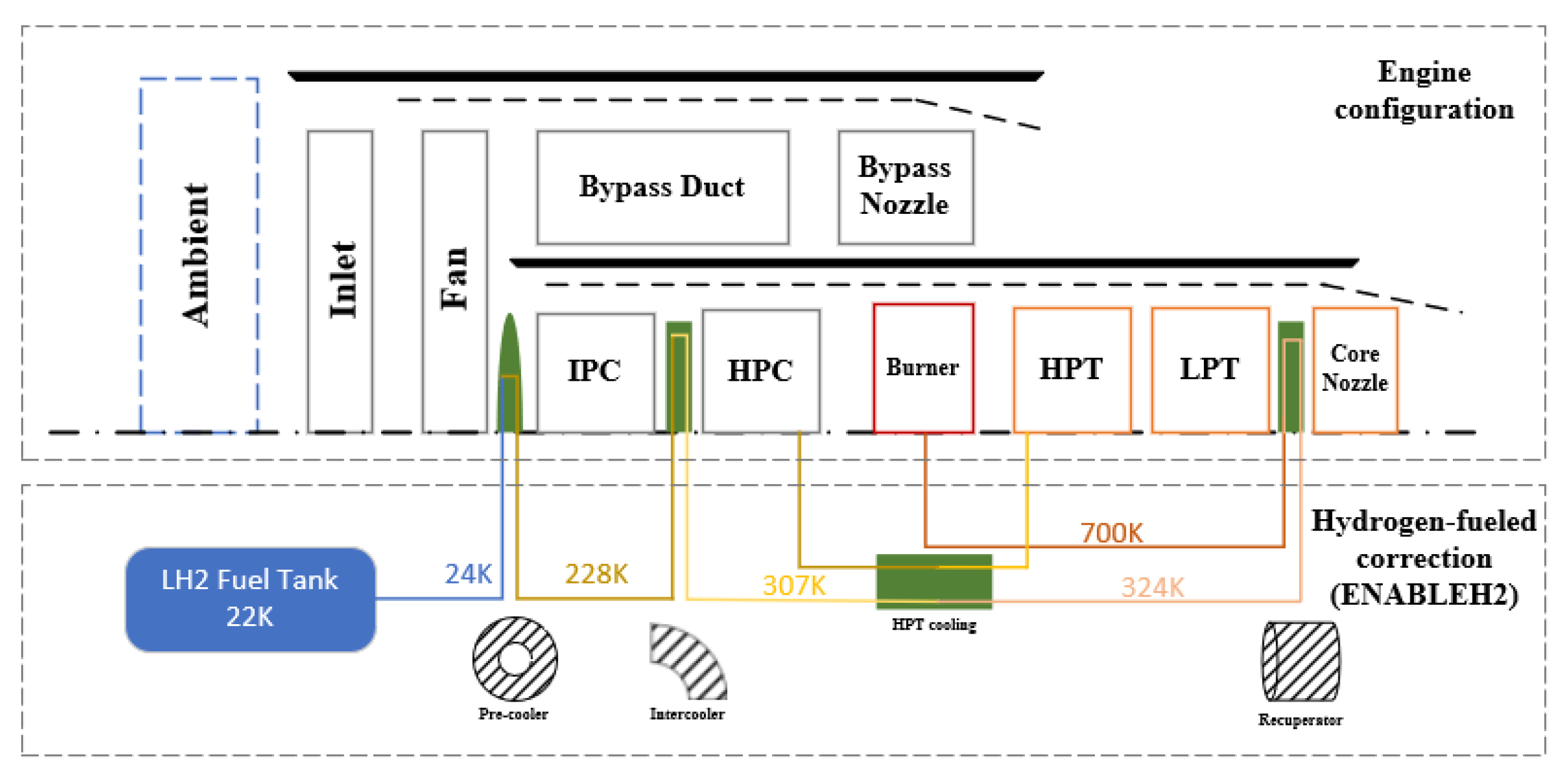
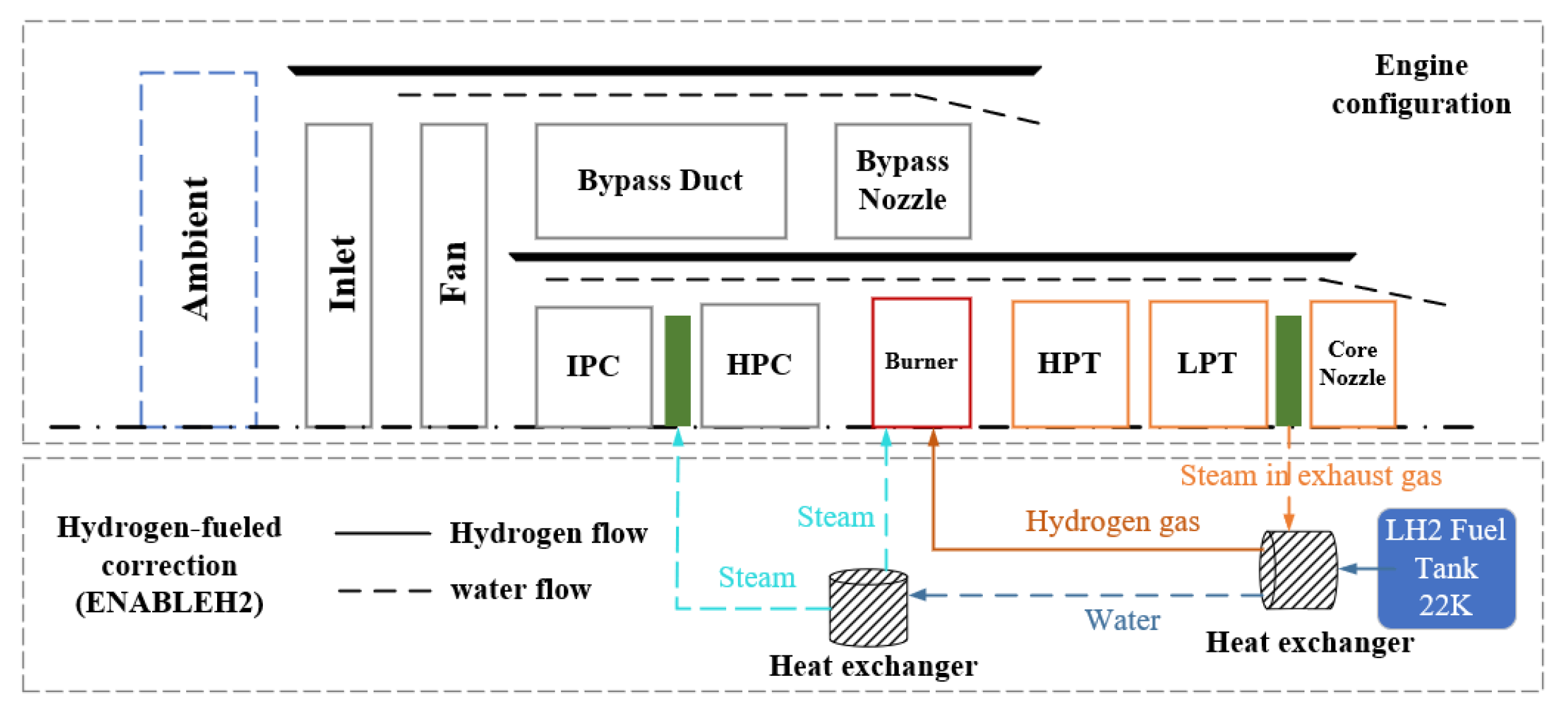
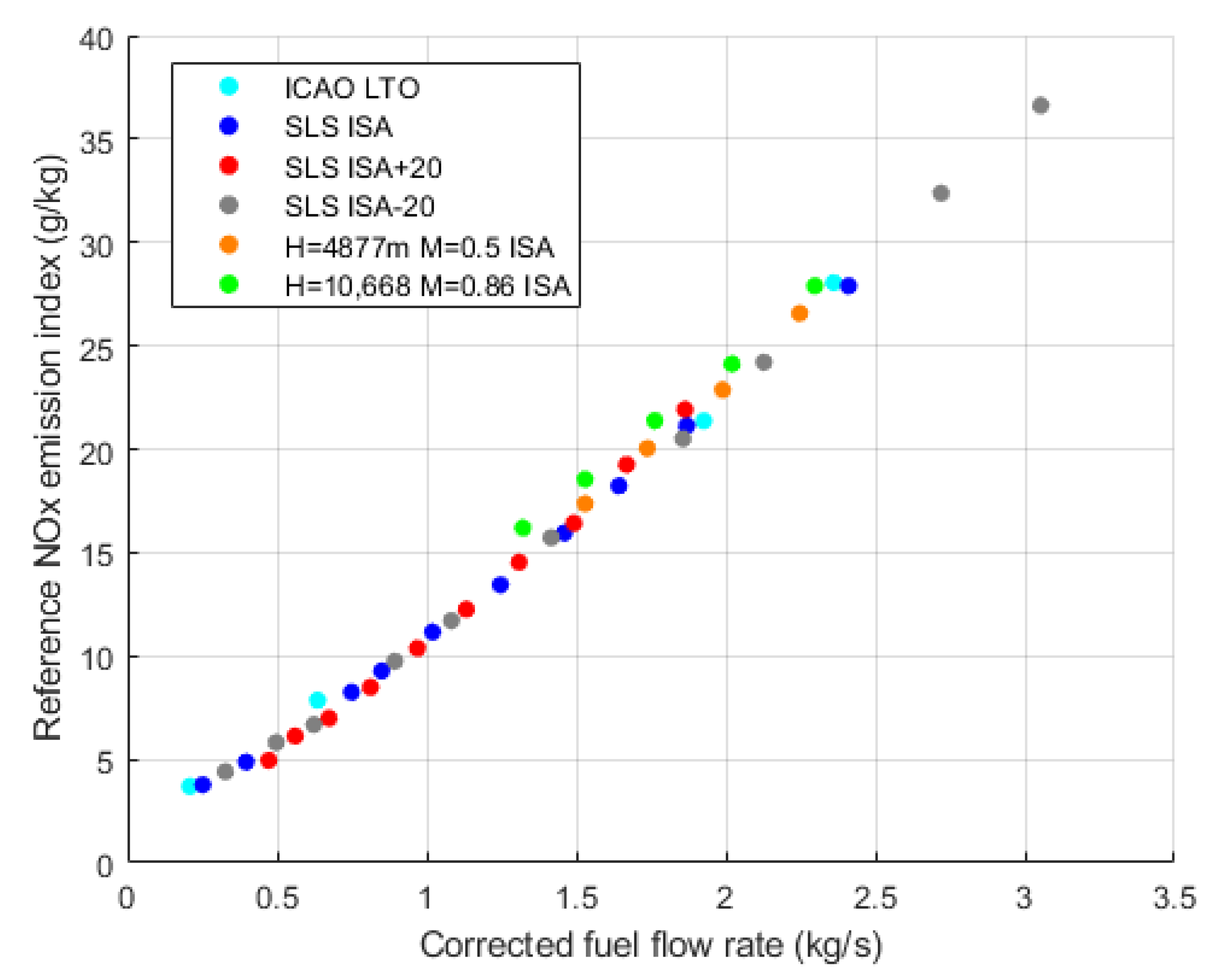
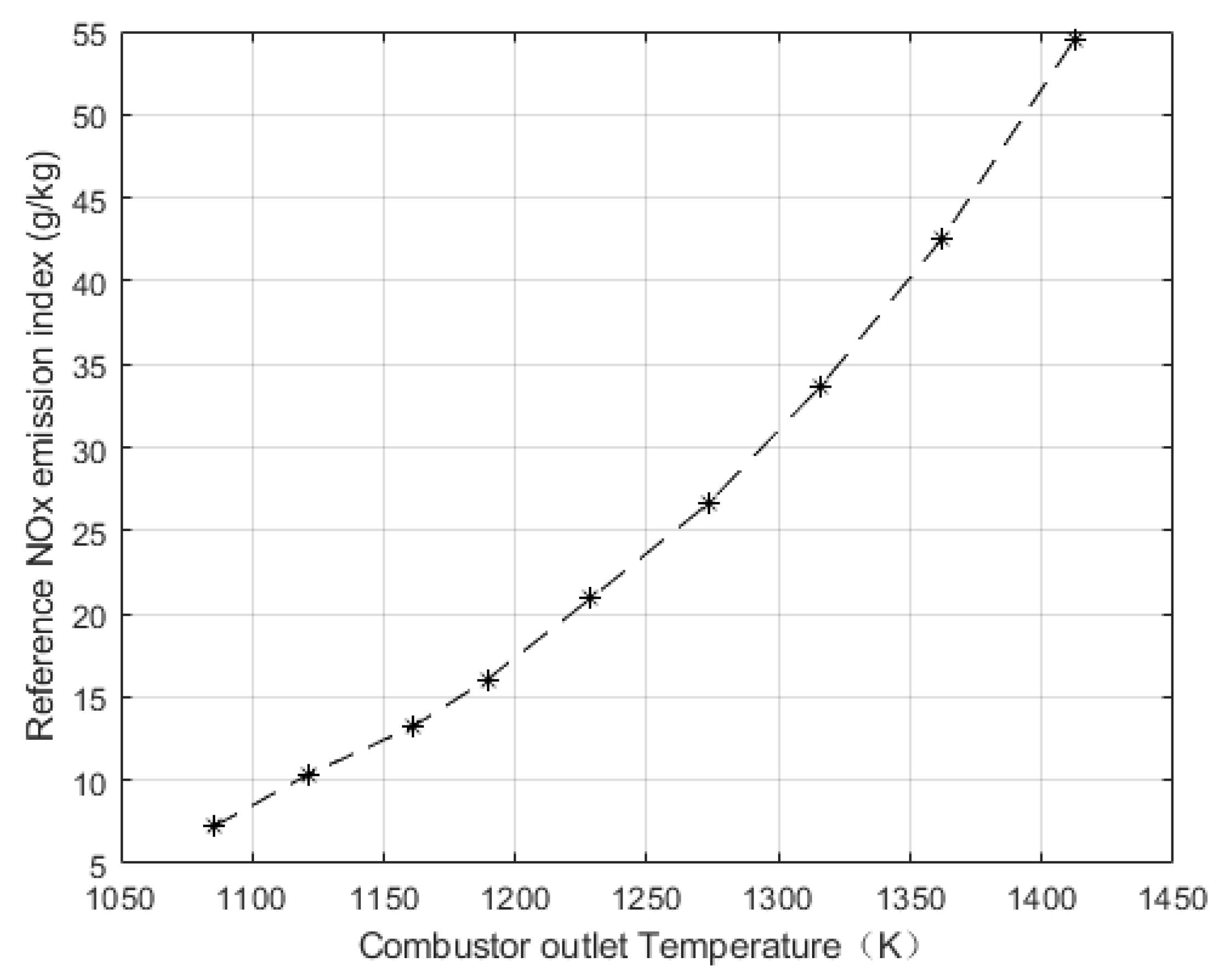
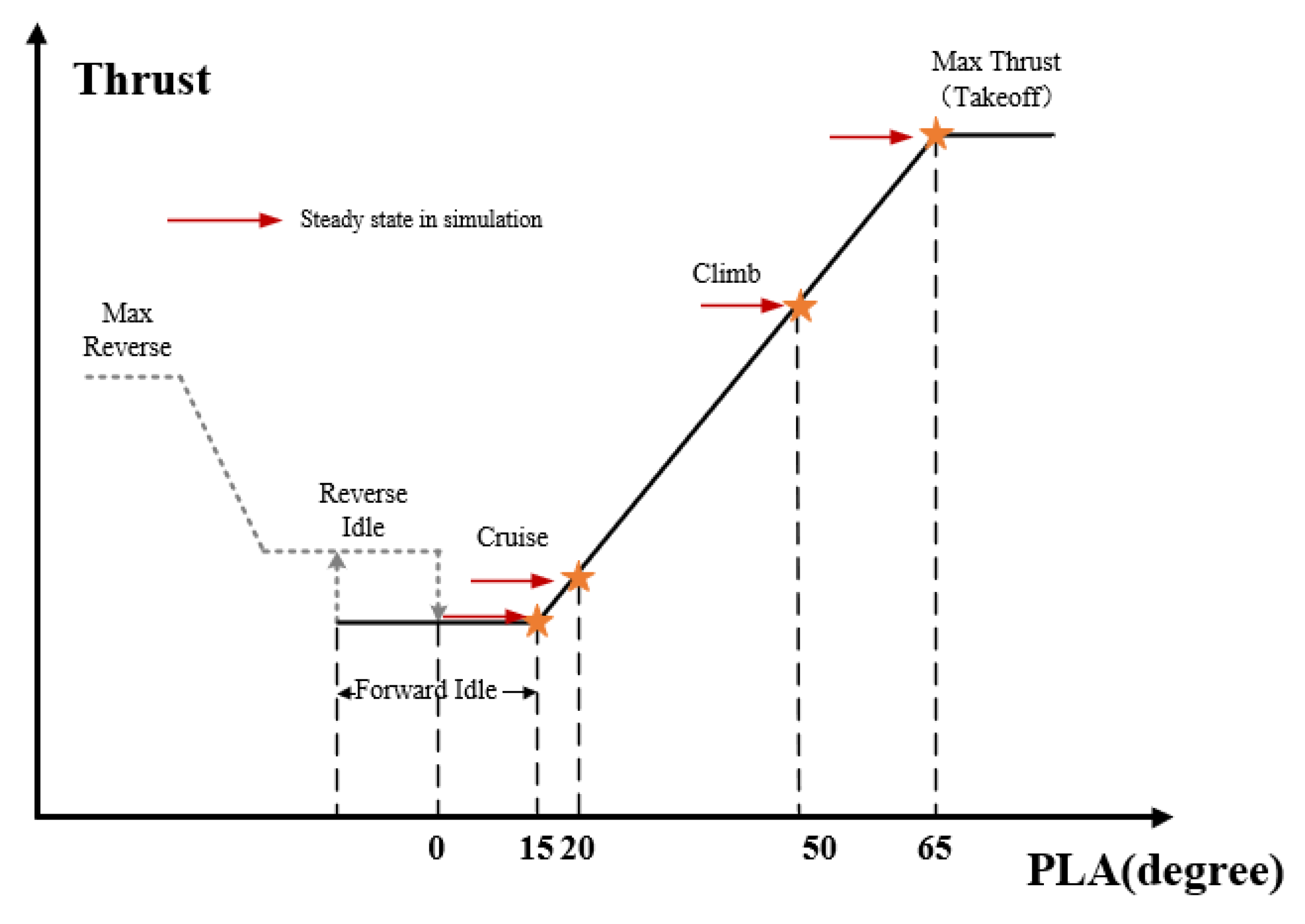

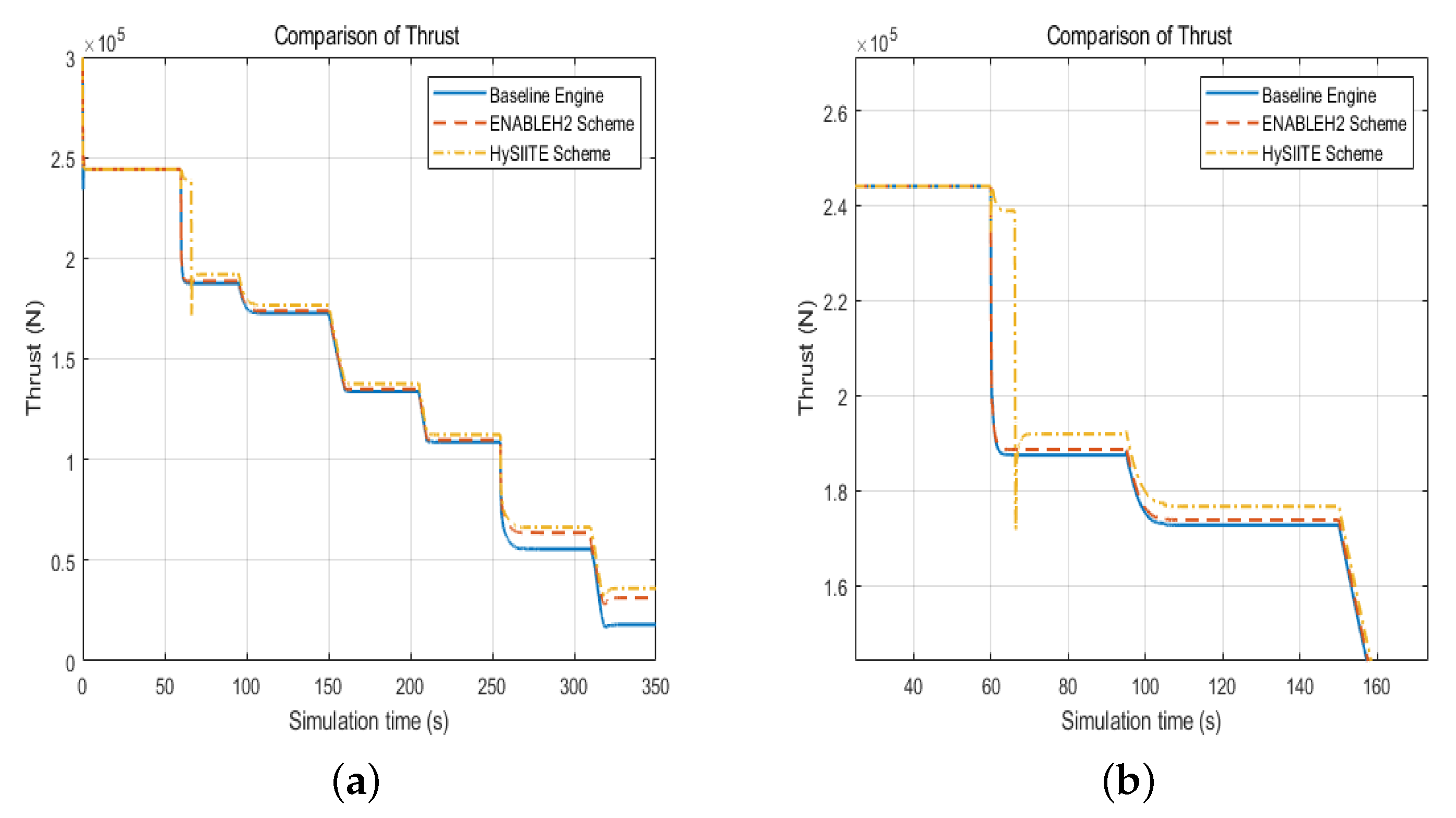
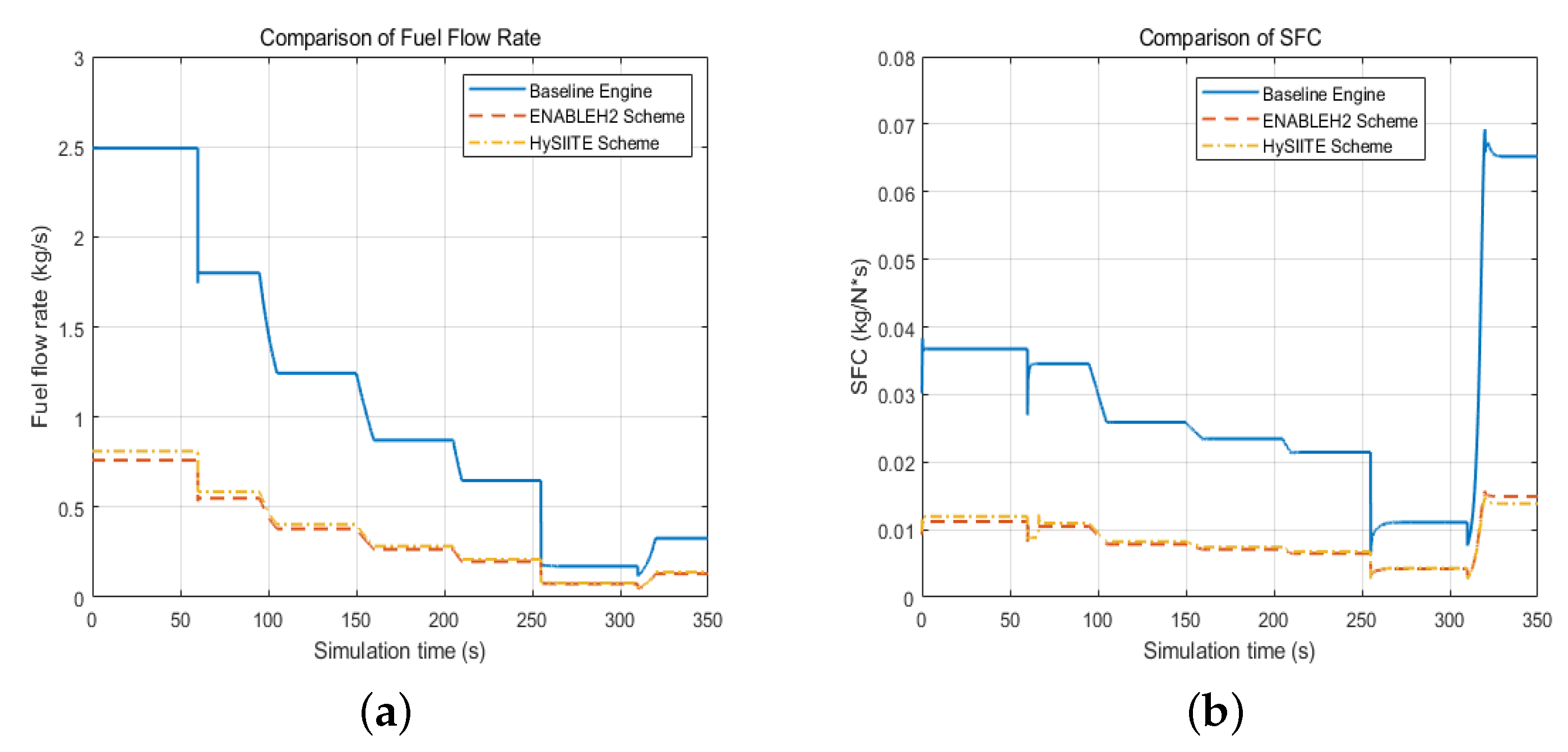
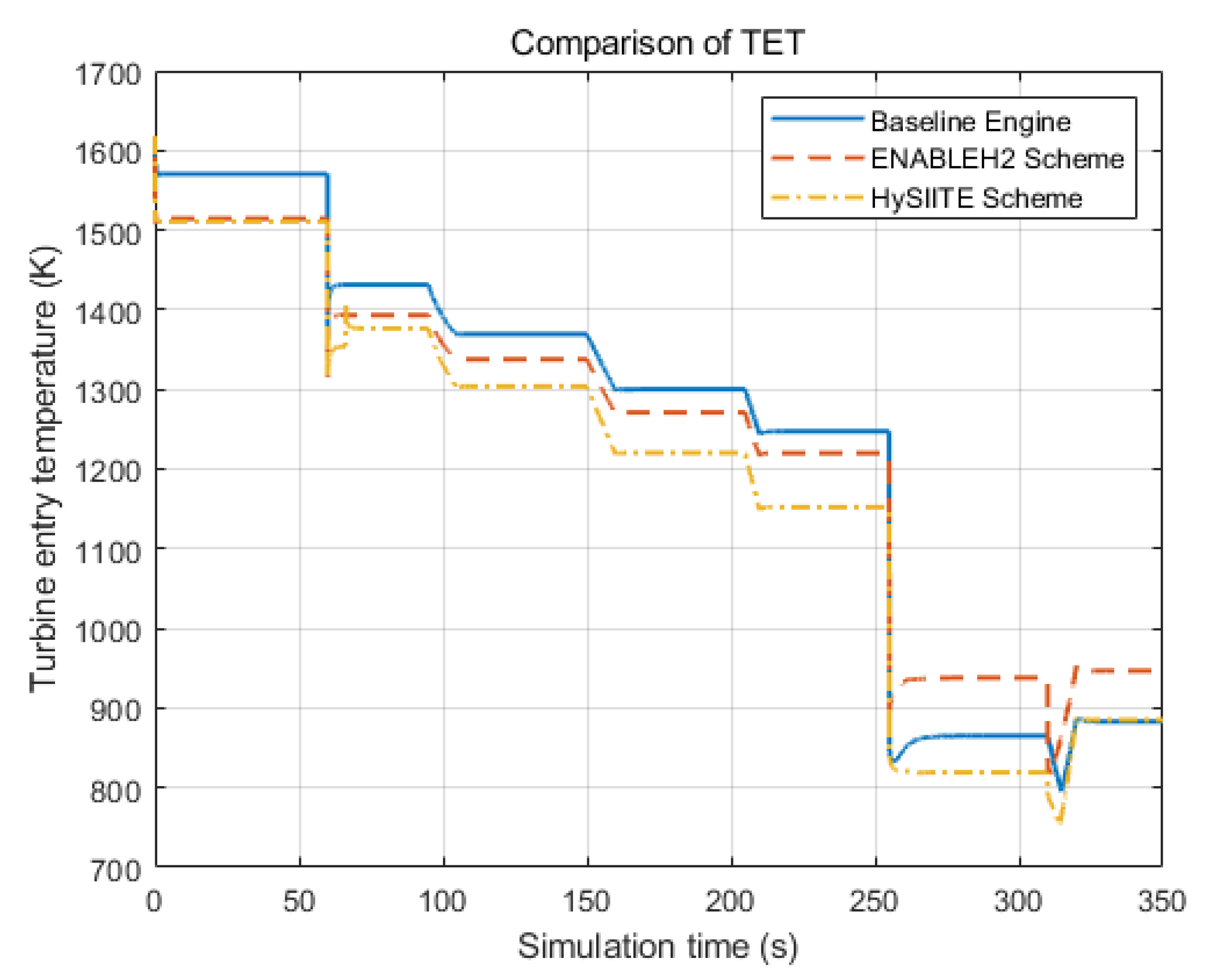
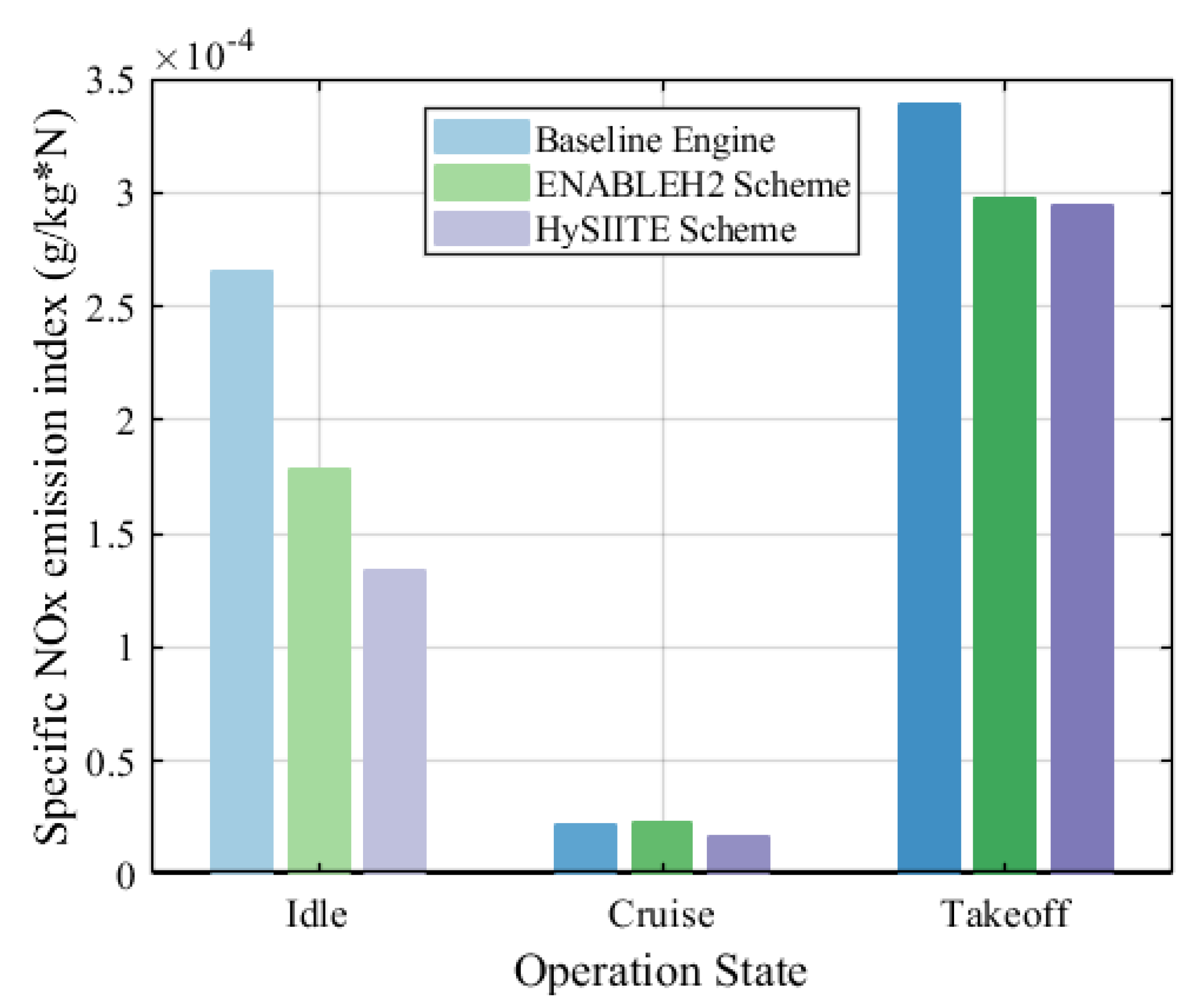




| State | Takeoff 1 | Takeoff 2 | Climb 1 | Climb 2 | Climb 3 | Cruise | Idle |
|---|---|---|---|---|---|---|---|
| Height (m) | 0 | 0 | 4500 | 7500 | 10,000 | 10,000 | 0 |
| Mach number | 0 | 0.2 | 0.6 | 0.7 | 0.8 | 0.77 | 0 |
| PLA (degree) | 65 | 50 | 50 | 50 | 50 | 20 | 15 |
| Idle | Cruise | Takeoff | |
|---|---|---|---|
| Baseline | 6.6677 | 9.3318 | 29.5893 |
| ENABLEH2 | 8.1080 | 11.8650 | 30.0469 |
| HySIITE | 8.7429 | 13.2675 | 30.7973 |
| Idle | Cruise | Takeoff | |||||||
|---|---|---|---|---|---|---|---|---|---|
| Baseline | ENABLEH2 | HySIITE | Baseline | ENABLEH2 | HySIITE | Baseline | ENABLEH2 | HySIITE | |
| Thrust (N) | 18,018.56 | 31,409.58 | 36,050.42 | 55,560.23 | 63,680.67 | 66,311.79 | 244,083.65 | 244,083.00 | 244,083.33 |
| SFC (kg/N*s) | 0.065233 | 0.014903 | 0.013847 | 0.011091 | 0.0041881 | 0.004289 | 0.036743 | 0.011202 | 0.011946 |
| TET (K) | 882.9705 | 946.741 | 885.0585 | 865.0847 | 937.8252 | 819.1171 | 1570.4416 | 1514.6401 | 1510.8762 |
| W2 (kg/s) | 215.2786 | 291.9656 | 316.113 | 239.9702 | 253.6827 | 258.5969 | 782.6713 | 783.8425 | 796.8 |
| (g/kg) | 6.5603 | 6.9754 | 6.588 | 1.6981 | 1.8853 | 1.322 | 82.8146 | 72.5875 | 71.9774 |
| (m/s) | 104.6981 | 123.0769 | 113.4915 | 182.5949 | 221.5216 | 195.1924 | 434.7032 | 415.9945 | 358.28 |
| (m/s) | 78.1037 | 106.3611 | 115.2574 | 258.7696 | 274.5102 | 280.0808 | 289.4343 | 289.876 | 294.7611 |
| FAR | 0.001516 | 0.00044536 | 0.0004386 | 0.0007133 | 0.00029203 | 0.00030551 | 0.0031829 | 0.00096895 | 0.0010165 |
Disclaimer/Publisher’s Note: The statements, opinions and data contained in all publications are solely those of the individual author(s) and contributor(s) and not of MDPI and/or the editor(s). MDPI and/or the editor(s) disclaim responsibility for any injury to people or property resulting from any ideas, methods, instructions or products referred to in the content. |
© 2023 by the authors. Licensee MDPI, Basel, Switzerland. This article is an open access article distributed under the terms and conditions of the Creative Commons Attribution (CC BY) license (https://creativecommons.org/licenses/by/4.0/).
Share and Cite
Wang, X.; He, A.; Hu, Z. Transient Modeling and Performance Analysis of Hydrogen-Fueled Aero Engines. Processes 2023, 11, 423. https://doi.org/10.3390/pr11020423
Wang X, He A, Hu Z. Transient Modeling and Performance Analysis of Hydrogen-Fueled Aero Engines. Processes. 2023; 11(2):423. https://doi.org/10.3390/pr11020423
Chicago/Turabian StyleWang, Xiting, Ai He, and Zhongzhi Hu. 2023. "Transient Modeling and Performance Analysis of Hydrogen-Fueled Aero Engines" Processes 11, no. 2: 423. https://doi.org/10.3390/pr11020423
APA StyleWang, X., He, A., & Hu, Z. (2023). Transient Modeling and Performance Analysis of Hydrogen-Fueled Aero Engines. Processes, 11(2), 423. https://doi.org/10.3390/pr11020423






